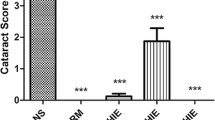Abstract
Oxidative stress has been proposed as a common underlying mechanism of cataractogenesis. Experimental and observational data suggest that micronutrients like vitamin C and vitamin E with antioxidant capabilities may retard the development of age-related cataract. Effect of these factors on lens epithelium cells, center of lens metabolic activities, is not completely elucidated. The aim of present study was to examine the effect of vitamin C and E on surgically removed lens epithelium cells of patients with cataract. Capsulorhexis samples were collected from 170 patients, admitted for cataract surgery. Catalase specific activity was estimated in lens epithelium cells with and without vitamin (C or E) treatment at different concentration for different time duration. Student’s t-test was employed for data analysis. We observed that in ex-vivo condition, a) both vitamin C and E bring about a decrease in catalase activity in lens epithelial cells. b) vitamin C showed toxic effect at high concentration. c) 100μM was the optimum concentration at which both vitamins showed maximum antioxidant activity. It was concluded that both vitamin C and E has direct effect on lens epithelium cells. At optimum concentration, they can reduce oxidative stress in these cells thus can support to prevent or delay cataract development.
Similar content being viewed by others
References
Murthy GV, Gupta SK, Maraini G, Camparini M, Price GM, Dherani M, et al. Prevalence of lens opacities in North India: the INDEYE feasibility study. Invest Ophthalmol Vis Sci 2007; 48(1): 88–95.
Doshna CM, Shen AC, Gebhard DF, Brees DJ, Somps CJ. Investigating Markers of DNA Oxidation, Lipid Peroxidation and Stress Response in Human Lens Epithelial Cell Lines. Invest Ophthalmol Vis Sci 2005; 46: E-Abstract 3850.
Jacques PF, Chylack LT. Epidemiologic evidence of a role for the antioxidant vitamins and carotenoids in cataract prevention. Am J Clin Nutr 1991; 53: 352S–355S.
Mares-Perlman JA, Brady WE, Klein BEK, Klein R, Haus GJ, Palta M, et al. Diet and nuclear lens opacities. Am J Epidemiol 1995; 141: 322–334.
Shang F, Lu M, Dudek E, Reddan J, Tayor A. Vitamin C and E restore the resistance of GSH-depleted lens cells to H2O2. Free Radical BioMed 2003; 34(5): 521–530.
Blondin J, Baragi VK, Schwartz ER, Sadowski J, Taylor A. Prevention of eye lens protein damage by dietary vitamin C. Invest Ophthalmol Vis Sci 1986; 27: 9–14.
Bhuyan KC, Bhuyan DK. Molecular mechanism of cataractogenesis-III.Toxic metabolites of oxygen as initiators of lipid peroxidation and cataract. Curr Eye Res 1984; 3(1): 67–81.
Spector A, Wang GM, Wang RR, Li WC, Kuszak JR. A brief photochemically induced oxidative insult causes irreversible lens damage and cataract. I. Transparency and epithelial cell layer. Exp Eye Res 1995, 60: 471–481.
Bates CJ, Chen SJ, Macdonald A, Holden R. Quantitation of vitamin E and a carotenoid pigment in cataract’s human lenses, and the effect of dietary supplement. Int J Vitam Nut Res 1996; 66: 316–321.
Tessier F, Moreaux V, Birlouez-Aragon I, Junes P, Mondon H. Decrease in vitamin C concentration in human lenses during cataract progression. Int J Vitam Nutr Res 1998; 68(5): 309–315.
Chylack LT Jr, Wolfe JK, Singer DM, Leske MC, Bullimore MA, Bailey IL, et al. The Lens Opacities Classification System III. The Longitudinal Study of Cataract Study Group. Arch Ophthalmol 1993; 111(6): 831–836.
Luck H. Catalase. In: Bergmeyer HU, editor. Methods of enzyme analysis. Academic Press: New York; 1971: 885 pp.
Waheed AA, Gupta PD. Estimation of submicrogram quantities of protein using the dye eosin Y. J Biochem Biophy methods 2000; 42: 125–32.
Dherani MK, Murthy GV, Gupta SK, Young I, Maraini G, Camparini M, et al. Blood levels of vitamin C, carotenoids and retinol are inversely associated with cataract in a north Indian population. Invest Ophthalmol Vis Sci 2008; 17: 1202.
Mathew JP, Thomas VC, Thomas I. Selenite cataract and its attenuation by vitamin E in Wistar rats. Ind J Ophthalmol. 2003; 51(2): 161–70.
Stewart-DeHaan PJ, Creighton MO, Sanwal M, Ross WM, Trevithick JR. Effects of vitamin E on cortical cataractogenesis induced by elevated temperature in intact rat lenses in medium 199. Exp Eye Res 1981; 32 (1): 51–60.
Alapure BV, Praveen MR, Gajjar D, Vasavada AR, Rajkumar S, Johar K. Matrix metalloproteinase-9 activity in human lens epithelial cells of cortical, posterior subcapsular, and nuclear cataracts. J Cataract Refract Surg 2008; 34(12): 2063–2067.
Gajjar D, Patel D, Alapure B, Praveen MR, Patel A, Johar K, et al. Rapid action of oestradiol against hydrogen peroxide-induced oxidative stress in cataractous lens epithelium: an in vitro study. Eye 2008; 23: 1456–1463.
Spector A, Ma W, Wang RR, Yang Y, Ho YS. The contribution of GSH peroxidase-1, catalase and GSH to the degradation of H2O2 by the mouse lens. Exp Eye Res 1997; 64: 477–485.
Lindau-Shepard BA, Shaffer JB. Expression of human catalase in acatalasemic murine SV-B2 cells confersprotection from oxidative damage. Free Radic Biol Med 1993; 15: 581–588.
Costarides AP, Riley MV, Green K. Roles of catalase and the glutathione redox cycle in the regulation of anteriorchamber hydrogen peroxide. Ophthalmic Res 1991; 23(5): 284–294.
Krepler K, Schmid R. Alpha-tocopherol in plasma, red blood cells and lenses with and without cataract. Am J Ophthalmol. 2005; 139(2): 266–270.
Varma SD, Kumar S, Richards RD. Light-induced damage to ocular lens cation pump: prevention by vitamin C. Proc Natl Acad Sci USA 1979; 76(7): 3504–3506.
Sztarbala T, Gos R, Kedziora J, Blaszczyk J, Sibinska E, Goralczyk M. Changes in the antioxidant system of the aqueous humor, lens and erythrocytes after sulfur hexafluoride. Klin Oczna 1998; 100: 73–75.
Klos-Rola J, Zagorski Z. Peroxidation of lipids in patients with senile cataract. Klin Oczna 2004; 106: 416–418.
Author information
Authors and Affiliations
Corresponding author
Rights and permissions
About this article
Cite this article
Goyal, M.M., Gajjar, D.U., Patel, D.B. et al. Effect of vitamin C and E activity on surgically removed cataractous human lens epithelium cells. Indian J Clin Biochem 24, 375–380 (2009). https://doi.org/10.1007/s12291-009-0068-0
Published:
Issue Date:
DOI: https://doi.org/10.1007/s12291-009-0068-0




